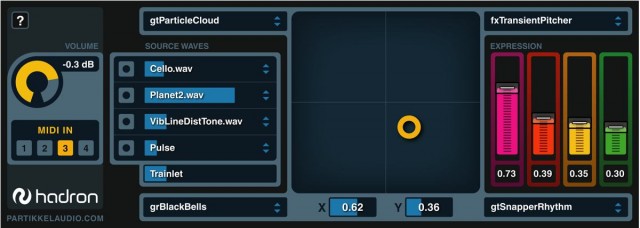Granular synthesis… you’ve heard it before. Famously articulated by experimental composer Xenakis, the process of slicing up sound into tiny bits and reassembling it has produced everything from lovely (or terrifying) synthesized sonorities to the underlying time stretching algorithms in popular music software. But with all the tools competing for your granular synthesis time (one seems to pop up every few seconds on the prolific Facebook page of sound designer Richard Devine), the Hadron Particle Synth promises to be different.
It’s a synth, but also an effect – and, for a twist, can seamlessly morph between the two, going from sound source to sound processor and shades in between. Its layering, parameter control, expression options, and all-around completeness lead its developers to confidently dub it “particle synthesis” and not just “granular synthesis.” And what may really convince you, it’s completely free, open source, runs and runs at release either inside Ableton Live as a Max for Live or within the free, geekily-delicious tool Csound. (Plug-ins for Mac and Windows are coming, too.) Whew. Now you’ve got my attention.
No video is out yet, but the Trondheim, Norway-based creators point CDM to their SoundCloud page for some sound samples.
Oeyvind Brandtsegg shares some delightful demo music for your sonic exploratory pleasure, complete with notes on its creation:
All of them made with Hadron as a primary ingredient.
The “Little Soldier Joe” songs are live recorded duo improvisations (Carl Haakon Waadeland on acoustic percussion and myself on Hadron).Little Soldier Joe walks home with the sugar by Brandtsegg
Little Soldier Joe throws spoonful of sugar in the air just to hear the sound of it falling by Brandtsegg
Little Soldier Joe throws spoonful of sugar in the air just to hear the sound of it falling by Brandtsegg
Little Soldier Joe wonders where he put his keys by Brandtsegg
Little Soldier Joe walks down to The Future to borrow a cup of sugar by Brandtsegg
“Ramblin”, “Walking” and “SpinSync” were actually made as Hadron demo songs (the programmed drums are the only sounds not made by Hadron).
WalkingAndFalling(in progress) by Brandtsegg
“Magnetic Forest” was my first electroacoustic composition with Hadron (three improvised overlaid tracks, recorded as midi and edited/composed)
Oeyvind Brandtsegg has a delightful selection of tracks for your sonic exploratory pleasure, with notes:
MagneticForest (in progress) by Brandtsegg
“FeedingTheCharmQuark” (1 and 2) are improvisations with audio feedback into Hadron, where pitch tracking of the audio input is used to control grain rate, so there’s some organic/unpredictable stuff happening as a result of the feedback loop.
More on the tool:
Hadron Released [News Item]
Partikkel Audio
The team of creators (sound designers, DSP gurus, and Max for Live aficionados all)
and for the really good bits (including that Csound source): Partikkel Downloads
By the way, if you’re wondering how the business model works here when everything’s free and open source, so far it looks like Partikkel, cleverly, has a Hadron expansion pack of “Time Dilation Effects.” Clever — free and open source software, plus what in gaming is called DLC (“downloadable content”). It could be The Future. Either way, it’s The Awesome for now.
I may fire up Csound this week so I can play with the source version. I also need to dig up the Csound for Pd external so I can use those two tools together. And of course I’ll use it in Max for Live, too, just to make sure there’s no chance my head doesn’t explode.
